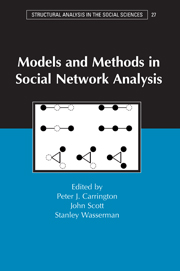Book contents
- Frontmatter
- Contents
- Acknowledgments
- Contributors
- 1 Introduction
- 2 Recent Developments in Network Measurement
- 3 Network Sampling and Model Fitting
- 4 Extending Centrality
- 5 Positional Analyses of Sociometric Data
- 6 Network Models and Methods for Studying the Diffusion of Innovations
- 7 Using Correspondence Analysis for Joint Displays of Affiliation Networks
- 8 An Introduction to Random Graphs, Dependence Graphs, and p*
- 9 Random Graph Models for Social Networks: Multiple Relations or Multiple Raters
- 10 Interdependencies and Social Processes: Dependence Graphs and Generalized Dependence Structures
- 11 Models for Longitudinal Network Data
- 12 Graphic Techniques for Exploring Social Network Data
- 13 Software for Social Network Analysis
- Index
- Structural Analysis in the Social Sciences
9 - Random Graph Models for Social Networks: Multiple Relations or Multiple Raters
Published online by Cambridge University Press: 05 June 2012
- Frontmatter
- Contents
- Acknowledgments
- Contributors
- 1 Introduction
- 2 Recent Developments in Network Measurement
- 3 Network Sampling and Model Fitting
- 4 Extending Centrality
- 5 Positional Analyses of Sociometric Data
- 6 Network Models and Methods for Studying the Diffusion of Innovations
- 7 Using Correspondence Analysis for Joint Displays of Affiliation Networks
- 8 An Introduction to Random Graphs, Dependence Graphs, and p*
- 9 Random Graph Models for Social Networks: Multiple Relations or Multiple Raters
- 10 Interdependencies and Social Processes: Dependence Graphs and Generalized Dependence Structures
- 11 Models for Longitudinal Network Data
- 12 Graphic Techniques for Exploring Social Network Data
- 13 Software for Social Network Analysis
- Index
- Structural Analysis in the Social Sciences
Summary
Introduction
Several chapters in this book outline some of the significant advances that have been made in modeling networks and network-based processes (see, for example, Chapters 6, 7, 10, and 11). These models generally presuppose a single network of interest, such as a network of acquaintance ties or a network of advice-seeking ties, and they represent the interdependence of such ties with actor characteristics and other ties in some local network neighborhood (see, for example, Chapter 10). Yet, there are compelling theoretical and methodological reasons to extend these models to the case of multiple networks, and in this chapter we discuss the rationale and nature of these extensions, as well as a number of issues to which they give rise.
From a theoretical perspective, it is more than likely that network processes involve different kinds of relational ties; indeed, some well-known hypotheses about the nature of local network processes involve multiple types of tie. Cartwright and Harary's (1956) adaptation of Heider's (1946) balance model, for example, proposes a strong form of interdependence among positive and negative ties within triadic network structures, and Granovetter's (1973) “strength of weak ties” thesis involves an interdependence between strong, weak, and null ties. In addition, there is an impressive body of empirical work that points to the importance of multiplex ties, that is, those ties in which several types of relationships come together – such as friend and coworker, or advisor and supervisor – and also to the consequences of such ties for interpersonal processes.
- Type
- Chapter
- Information
- Models and Methods in Social Network Analysis , pp. 162 - 191Publisher: Cambridge University PressPrint publication year: 2005
- 23
- Cited by



